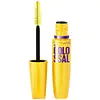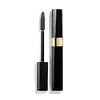What's inside
What's inside
 Key Ingredients
Key Ingredients

 Benefits
Benefits

 Concerns
Concerns

 Ingredients Side-by-side
Ingredients Side-by-side

Water
Skin ConditioningParaffin
PerfumingPotassium Cetyl Phosphate
EmulsifyingBeeswax
Emulsion StabilisingCopernicia Cerifera Wax
Acacia Senegal Gum
MaskingGlycerin
HumectantCetyl Alcohol
EmollientHydroxyethylcellulose
Emulsion StabilisingSodium Polymethacrylate
Emulsion StabilisingHydrogenated Jojoba Oil
AbrasiveHydrogenated Palm Oil
EmollientPhenethyl Alcohol
MaskingPhenoxyethanol
PreservativeSteareth-20
CleansingPEG/PPG-17/18 Dimethicone
EmulsifyingPolyquaternium-10
Silica
AbrasiveSoluble Collagen
HumectantSimethicone
EmollientPanthenol
Skin ConditioningDisodium EDTA
CI 77491
Cosmetic ColorantCI 77492
Cosmetic ColorantCI 77499
Cosmetic ColorantCI 77891
Cosmetic ColorantCI 77007
Cosmetic ColorantCI 77288
Cosmetic ColorantCI 77289
Cosmetic ColorantCI 77742
Cosmetic ColorantCI 77510
Cosmetic ColorantMica
Cosmetic ColorantWater, Paraffin, Potassium Cetyl Phosphate, Beeswax, Copernicia Cerifera Wax, Acacia Senegal Gum, Glycerin, Cetyl Alcohol, Hydroxyethylcellulose, Sodium Polymethacrylate, Hydrogenated Jojoba Oil, Hydrogenated Palm Oil, Phenethyl Alcohol, Phenoxyethanol, Steareth-20, PEG/PPG-17/18 Dimethicone, Polyquaternium-10, Silica, Soluble Collagen, Simethicone, Panthenol, Disodium EDTA, CI 77491, CI 77492, CI 77499, CI 77891, CI 77007, CI 77288, CI 77289, CI 77742, CI 77510, Mica
Water
Skin ConditioningOryza Sativa Bran Wax
Skin ConditioningSucrose Stearate
EmollientCopernicia Cerifera Wax
Cera Alba
EmollientPolybutene
Cetyl Alcohol
EmollientStearyl Alcohol
EmollientHydroxyethylcellulose
Emulsion StabilisingPhenylpropanol
MaskingPropanediol
SolventChlorphenesin
AntimicrobialCaprylyl Glycol
EmollientPanthenol
Skin ConditioningCellulose
AbsorbentPolyquaternium-10
Tocopherol
AntioxidantCI 75470
Cosmetic ColorantCI 77000
Cosmetic ColorantCI 77007
Cosmetic ColorantCI 77163
Cosmetic ColorantCI 77288
Cosmetic ColorantCI 77491
Cosmetic ColorantCI 77492
Cosmetic ColorantCI 77499
Cosmetic ColorantCI 77510
Cosmetic ColorantCI 77742
Cosmetic ColorantCI 77891
Cosmetic ColorantMica
Cosmetic ColorantWater, Oryza Sativa Bran Wax, Sucrose Stearate, Copernicia Cerifera Wax, Cera Alba, Polybutene, Cetyl Alcohol, Stearyl Alcohol, Hydroxyethylcellulose, Phenylpropanol, Propanediol, Chlorphenesin, Caprylyl Glycol, Panthenol, Cellulose, Polyquaternium-10, Tocopherol, CI 75470, CI 77000, CI 77007, CI 77163, CI 77288, CI 77491, CI 77492, CI 77499, CI 77510, CI 77742, CI 77891, Mica
 Reviews
Reviews

Ingredients Explained
These ingredients are found in both products.
Ingredients higher up in an ingredient list are typically present in a larger amount.
Cetyl Alcohol is a fatty alcohol. Fatty Alcohols are most often used as an emollient or to thicken a product.
Its main roles are:
Though it has "alcohol" in the name, it is not related to denatured alcohol or ethyl alcohol.
The FDA allows products labeled "alcohol-free" to have fatty alcohols.
Learn more about Cetyl AlcoholThis pigment is called Ultramarine blue lazurite. It gives a saturated blue color, but can be used to create other colors as well.
According to the manufacturer, it is usually made from kaolin, sodium sulfate, sodium carbonate, sulfur, and charcoal.
Ci 77288 is used to add green pigment to products.
Ci 77491 is also hydrated iron III oxide. It's sole purpose is to give a red/pink hue to products.
Iron III oxides are classified as inorganic chemicals for coloring.
Synthetically created Ci 77491 is considered safer than those naturally found. This is because the synthetically created version may contain less impurities. Iron oxides are generally non-toxic and non-allergenic.
Learn more about CI 77491Ci 77492 is also hydrated iron III oxide. It's sole purpose is to give a yellow hue to products.
Iron III oxides are classified as inorganic chemicals for coloring.
Synthetically created Ci 77492 is considered safer than those naturally found. This is because the synthetically created version may contain less impurities. Iron oxides are generally non-toxic and non-allergenic.
Learn more about CI 77492Ci 77499 is also hydrated iron III oxide. It is created from mixing red and black iron oxides. This helps give shades of darkness to a product.
Iron III oxides are classified as inorganic chemicals for coloring.
This ingredient is used to impart a blue color. It is not water-soluble.
It goes by two different names:
1. Ferric Ferrocyanide: a synthetic dark blue pigment
2. Ferric Ammonium Ferrocyanide: a synthetic blue pigment, also called Prussian blue
In the EU, both of these colors must be labeled as 'CI 77510'.
Learn more about CI 77510This ingredient is used to add a violet color to cosmetics.
It is created by reacting phosphoric acid, ammonium dihydrogen orthophosphate, and manganese dioxide.
Ci 77891 is a white pigment from Titanium dioxide. It is naturally found in minerals such as rutile and ilmenite.
It's main function is to add a white color to cosmetics. It can also be mixed with other colors to create different shades.
Ci 77891 is commonly found in sunscreens due to its ability to block UV rays.
Learn more about CI 77891Copernicia Cerifera Wax comes from a palm tree native to Brazil; another name for this ingredient is Carnauba Wax.
This ingredient is used to thicken texture and also leaves behind a film when applied.
Fun fact: This wax has the highest melting point of all natural waxes and low solubility.
Learn more about Copernicia Cerifera WaxHydroxyethylcellulose is used to improve the texture of products. It is created from a chemical reaction involving ethylene oxide and alkali-cellulose. Cellulose is a sugar found in plant cell walls and help give plants structure.
This ingredient helps stabilize products by preventing ingredients from separating. It can also help thicken the texture of a product.
This ingredient can also be found in pill medicines to help our bodies digest other ingredients.
Learn more about HydroxyethylcelluloseMica is a naturally occurring mineral used to add shimmer and color in cosmetics. It can also help improve the texture of a product or give it an opaque, white/silver color.
Serecite is the name for very fine but ragged grains of mica.
This ingredient is often coated with metal oxides like titanium dioxide. Trace amounts of heavy metals may be found in mica, but these metals are not harmful in our personal products.
Mica has been used since prehistoric times throughout the world. Ancient Egyptian, Indian, Greek, Roman, Aztec, and Chinese civilizations have used mica.
Learn more about MicaPanthenol is a common ingredient that helps hydrate and soothe the skin. It is found naturally in our skin and hair.
There are two forms of panthenol: D and L.
D-panthenol is also known as dexpanthenol. Most cosmetics use dexpanthenol or a mixture of D and L-panthenol.
Panthenol is famous due to its ability to go deeper into the skin's layers. Using this ingredient has numerous pros (and no cons):
Like hyaluronic acid, panthenol is a humectant. Humectants are able to bind and hold large amounts of water to keep skin hydrated.
This ingredient works well for wound healing. It works by increasing tissue in the wound and helps close open wounds.
Once oxidized, panthenol converts to pantothenic acid. Panthothenic acid is found in all living cells.
This ingredient is also referred to as pro-vitamin B5.
Learn more about PanthenolPolyquaternium-10 is an ammonium salt of hydroxyethylcellulose. It is a white and granular powder used as a film-former and anti-static agent.
This ingredient is commonly found in hair conditioning products. According to a manufacturer, its positive charge makes it great for absorbing hair proteins. The manufacturer also states this ingredient helps with curl retention.
For haircare friends: this ingredient is not a silicone.
Learn more about Polyquaternium-10Water. It's the most common cosmetic ingredient of all. You'll usually see it at the top of ingredient lists, meaning that it makes up the largest part of the product.
So why is it so popular? Water most often acts as a solvent - this means that it helps dissolve other ingredients into the formulation.
You'll also recognize water as that liquid we all need to stay alive. If you see this, drink a glass of water. Stay hydrated!
Learn more about Water